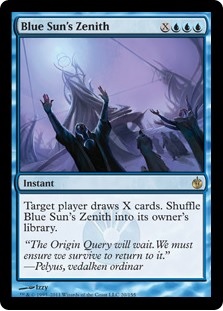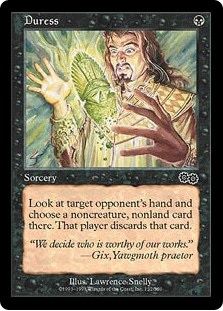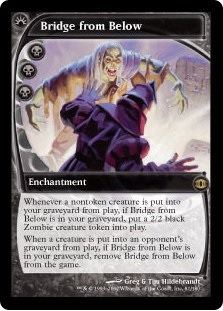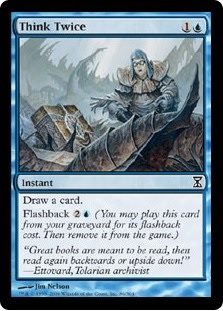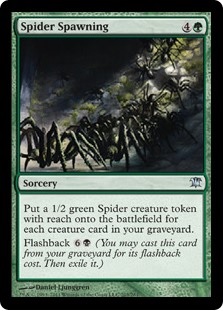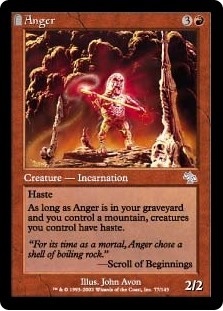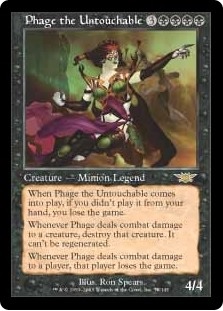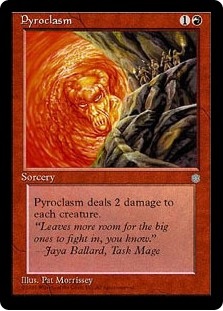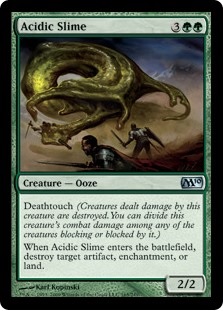Go back in time to see more from this series.
38. Blue Sun's Zenith
Once upon a time, players had to devise their own ways of not decking themselves if things went sort of cat-tywompus with the Braingeyser or the Stroke of Genius. You had to Feldon's Cane or Elixir of Immortality or something. Now it just doesn't matter because you can win outright with Thassa's Oracle (a miserable and ridiculous Magic card, by the way); however, back then you got to enjoy your own place in that creative strategic process.
Blue Sun's Zenith is a self-fixer, but not in the lazy and empty Thassa's Oracle expe-rience kind of way. It asks for triple Blue, instead of the aforementioned variations, and it self-regulates with-out just bailing you out, let alone letting you win the game outright. It asks for the right amount of resources, it does the right amount in return, and it's something to love in a template that has since gotten a bad name from cards like Expansion // Explosion, Sphinx's Revelation, and Hydroid Kra-sis. BSZ solves the perfect amount of problems, and when all of your peers are solving so many that they're boring, that's worthy of applause.
37. Duress
Before Thoughtseize and all its pain in the ass friends made Magic less and less like poker with every casting, there was a card that did really, really good work against unfair decks. It still gets reprinted all the time now, which really only serves to highlight its original potential. I guess that's the theme today: other cards screwing up great ones.
Because when Duress is pretty good, Magic is pretty good. When cards that are Duress but straight up better are legal, they're everywhere on a good day, and I'm not sure that makes for anything special.
Speaking of special...
36. Bridge From Below
If you subtract that dredge was a development failure and an affront to good sense, you can start to see this card better for what it is, rather than what it ended up being.
Let's compare it to something like Waste Not, where the text reads like a flow chart with a bunch of instructional directions but not a ton of catharsis at the end of it. It feels as much like an index as a game piece.
On the other hand, Bridge From Below is a card with text that seems untethered and strange as you proceed through it, but by the end, you understand not just the cohesion of its functionality but also how refreshingly different it is than anything else you know. Cards have had lots of reasons to be fine with being in the graveyard over the years, but here was a card that only worked if it was there. How was this card even developed? How did they decide how to cost it? Why did [ma-na]{B}{B}{B}[/mana] end up with the spot? How many amazing corner cases have we missed on this odd duck because it's eternally tethered to godawful Magic mechanics in Eternal formats?
This is a fascinating Magic card and it's a great case for learning the distinction between cards that just have lots of text that may be more or less tied in together versus a card with a worthy payoff experience in coming to understand how everything lies together. If you want another comparison example on this distinction for homework/extra credit, try Questing Beast and Grand Archi-tect.
35. Think Twice
So imagine it's not 2020 and the ability to draw cards or generate virtual cards isn't basically on everything. Imagine a world where cycling isn't just something people do all the time. That's how you appreciate Think Twice. It's a card so cool and wonderful that you can easily compare it to the Urza Block mechanic so neat they do it all the time in every color now! Think Twice is still more interesting than those cards.
34. Spider Spawning
Speaking of flashback, this card did the following things:
- Illustrated an interesting new use for a popular mechanic.
- Highlighted the set's horror themes.
- Enabled strange, novel combos.
- Changed the way mainstream competitive Magic players explored and understood Limited.
- Made a new kind of token players were super into (and they're always into tokens anyway).
- Scaled as well in individual games of Limited as it did in Commander.
There's probably more, but I need to move on. This card has legs. (~_^)
33. Anger
This design (see also: Wonder) hasn't aged well on account of two things: 1.) Creatures keep getting bigger and nuttier, and 2.) It's really easy to discard things and abuse the graveyard now.
I mean look at that top right card corner! The cards in Odyssey Block were so graveyard-centric and the graveyard was such a flat out "discard zone" for every color but Black that WotC felt they had to give you a constant reminder that this card was still alive, even when dead! Especially when dead! That seems pretty insane now that Magic is as much about the graveyard as the hand, if not more.
It's sort of like flashback, see.
Anyway, this is pretty close in spirit to the comments I made about these other cards, especially Bridge From Below. The context of mistakes around the card's play among the tryhard Magic circles of world history really hides how clever the idea initially was. And for this card, you don't even need to read a bunch of words!
32. Phage the Untouchable
Everything that Emrakul, the Promised End; Jace, the Mind Sculptor; Oko, Thief of Crowns; and Gideon, Ally of Zendikar sucked at, Phage is awesome at.
You see, before we had Standard and Commander ideals intentionally trying to represent most of new Magic design, we had story cards that could be both powerful and not com-pletely tournament degenerate and cumbersome.
Phage is the poster child for shelf life. Nobody will ever enjoy playing against Teferi again, but Phage is still a laugh years later.
Is this that hard?
31. Vampire Hexmage
On the opposite end of the spectrum from innocent cards hanging with the wrong crowd is Vampire Hexmage (ignore her love affair with Marit Lage), a card so flexible and eloquent that it emulates old school stack damage perfectly, it has interesting combat patterns, planeswalkers and an obsession with dou-bling and tripling counters make it continuously more useful, and absolutely nothing it does feels unfair or forced. The old school Black Knight sort of fair but ugly role should forevermore go to this card. Reprint it yearly. No one is going to stop playing Magic because the new $35 Karn or Chan-dra traded with a 2/1 for two. Based on contemporary reviews, I'd be more concerned about the opposite scenario, honestly.
30. Pyroclasm
I don't think I need to explain this one at all.
Talk about an achievement. I love explaining!
29. Acidic Slime
We finish out today with another flexible card that encompasses all the happy and fair enters the battlefield rates that somewhere along the line over the last few years just got thrown right the hell out the window.
Spoilers: Uro will not be appearing on the list.
But another very controversial pick is up next! It has maybe the most bemoaned enters the battlefield ability in recent memory. And yet it's a great design?! How can this be?!
See you back here again soon for the answers.
(~_^)
The Rascal
The Indestructible Danny West
















